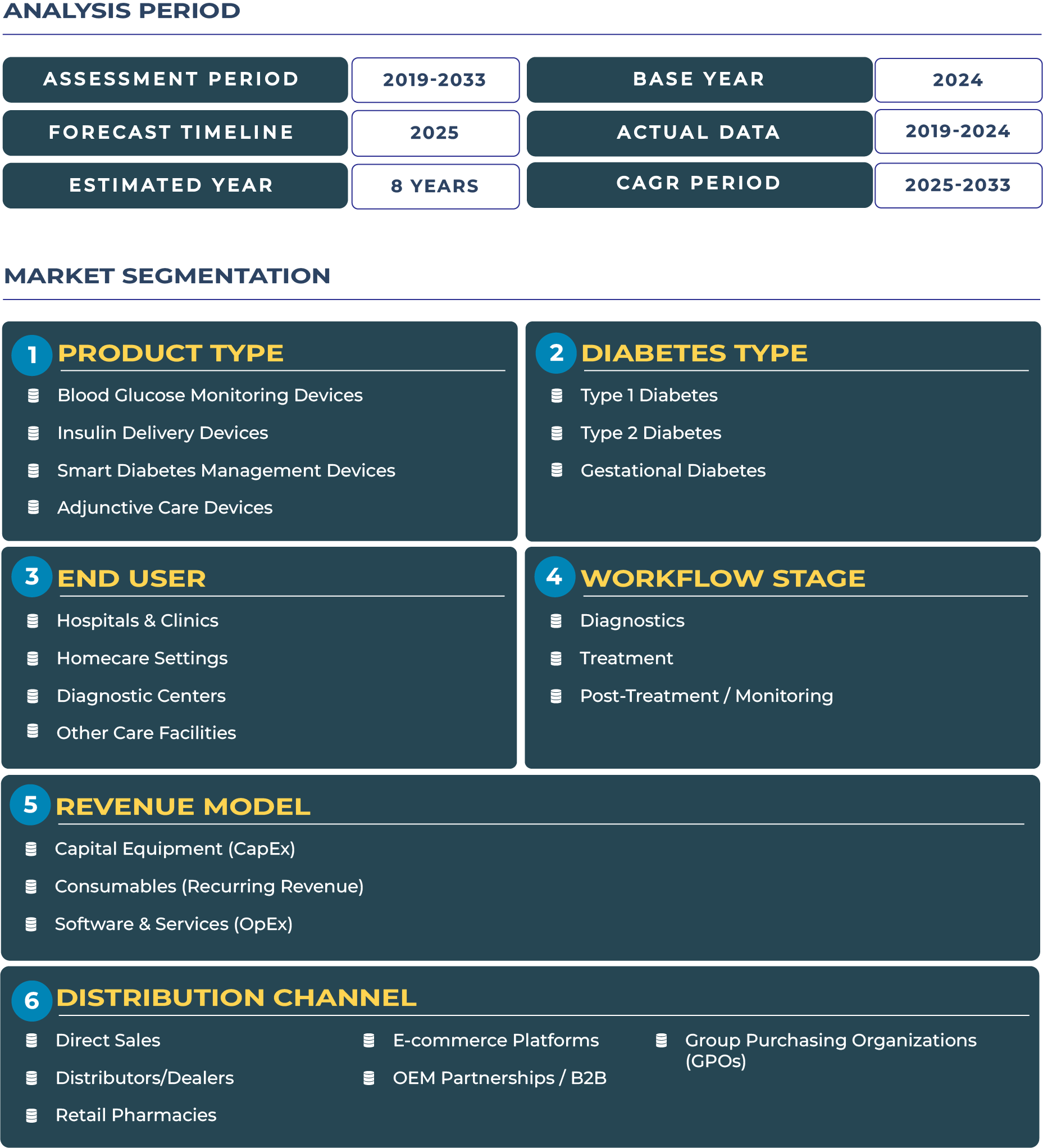Report Format:
![]()
![]() |
Pages: 110+
|
Pages: 110+
Nigeria diabetes care devices Market Outlook: Unlocking Access through Affordability and Distribution Scale
Nigeria healthcare landscape is defined by its vast population and urgent need for accessible chronic disease management. In the diabetes care devices market, the country is increasingly focusing on ultra-affordable solutions and leveraging pharmacy and telecom distribution networks to ensure broader access. The imperative is clear: with millions of individuals requiring timely glucose monitoring and insulin delivery, affordability and distribution reach have become the twin pillars of market growth. The Nigeria diabetes care devices industry is estimated to reach USD 81.2 million in 2025 and expand to USD 149.7 million by 2033, reflecting a CAGR of 7.9%. This momentum stems from Nigeria’s drive toward scalable models that combine low-cost consumables, pharmacy-driven distribution, and digital health tie-ins. Such an approach enables manufacturers and healthcare providers to expand their footprint across urban centers and underserved rural regions, positioning the country as a critical growth market within the global diabetes care devices ecosystem.
Why Affordable Solutions and Distribution Partnerships Define the Future of Nigeria diabetes care devices Sector
The outlook for Nigeria diabetes care devices market is firmly anchored in the need to democratize access through cost-effective products and innovative distribution strategies. With more than 220 million people, Nigeria presents one of the largest untapped opportunities in the global diabetes care devices landscape. Yet, penetration of monitoring and insulin delivery technologies remains limited, largely due to affordability constraints and fragmented healthcare infrastructure. By 2033, the market is projected to nearly double its size, underscoring the significant role of affordability-focused innovations. Partnerships with pharmacy chains and telecom operators are emerging as the most viable route to scale. Pharmacies, already serving as first-line healthcare providers for a majority of Nigerians, can become natural distribution hubs for blood glucose monitoring strips and devices, while telecom-led digital health programs enable remote education and monitoring. Despite challenges such as economic volatility and healthcare budget constraints, Nigeria diabetes care devices ecosystem is primed for growth by emphasizing ultra-low-cost solutions and scalable access models.
Drivers and Restraints: Navigating Growth Imperatives and Systemic Challenges in the Nigeria Diabetes Care Devices Landscape
One of the strongest drivers shaping Nigeria diabetes care devices sector is its very large, under-served population. According to the National Bureau of Statistics, the growing prevalence of non-communicable diseases is creating demand for reliable self-monitoring and insulin delivery technologies. Yet, device penetration remains low, creating immense headroom for expansion. Additionally, rapid urbanization and rising middle-class income levels are increasing awareness of diabetes care, encouraging the adoption of continuous glucose monitoring and smart diabetes management platforms. Global medtech players and local distributors are tapping into these opportunities by aligning with retail pharmacies and NGOs to deliver affordable solutions to a wider audience.
However, systemic challenges persist. Affordability constraints remain the single largest barrier to widespread adoption. Many patients struggle with the recurring costs of glucose strips and insulin delivery devices, limiting long-term adherence. Distribution bottlenecks, such as cold-chain requirements for insulin and limited reach into rural communities, further hinder device access. Import tariffs and fluctuating exchange rates add to pricing pressures, creating barriers for global vendors looking to penetrate the Nigerian market. These restraints highlight the need for innovative financing models, bulk procurement strategies, and stronger public-private collaborations to ensure sustainable adoption of diabetes care devices.
Trends and Opportunities: Scaling Low-Cost Innovations and Expanding Access through Strategic Partnerships
A key trend shaping Nigeria diabetes care devices industry is the growing demand for affordable continuous glucose monitoring (CGM) devices and consumables. Manufacturers are increasingly focusing on low-cost CGM systems and simplified insulin delivery solutions to capture the mass market. The success of such models hinges on ensuring steady supply of consumables like test strips and infusion sets at accessible price points. In urban centers such as Lagos and Abuja, the growing penetration of private hospitals and diagnostic centers is fueling interest in smart diabetes management devices that integrate with mobile health platforms, enabling better patient-doctor engagement.
Opportunities also abound in expanding distribution through pharmacy and telecom networks. Pharmacies already play a central role in Nigeria’s healthcare access, while telecom operators offer unmatched scale in digital engagement. Partnerships between diabetes care device vendors and these sectors can reduce distribution friction and create sustainable models for market penetration. For example, co-branded diabetes education and device awareness campaigns run through telecom platforms can drive adoption across remote and peri-urban regions. Similarly, expanding NGO collaborations with pharmacy networks could enable subsidized device access for low-income populations. Together, these trends and opportunities reflect how Nigeria diabetes care devices sector can grow by aligning affordability with scale-driven distribution strategies.
Competitive Landscape: Local Adaptation and International Partnerships Define Nigeria diabetes care devices Ecosystem
The competitive landscape of Nigeria diabetes care devices market is evolving rapidly, with both international and local players adopting strategies to reach mass markets. In 2023, Abbott launched awareness and distribution initiatives for its FreeStyle Libre system through regional pharmacy channels, expanding CGM availability across Nigerian cities. This approach highlights the importance of pharmacy networks as a primary channel for device penetration. Local distributors are complementing these initiatives by offering affordable blood glucose monitoring kits designed for wide-scale use, ensuring product availability in urban retail outlets and community pharmacies.
A recurring strategy is the integration of telco and pharmacy networks to achieve national-scale distribution. Such collaborations reduce last-mile friction and enable vendors to penetrate both urban and rural populations. Global manufacturers are also increasingly collaborating with Nigerian NGOs to expand device access through subsidized programs, focusing on affordability and awareness. These strategies demonstrate how Nigeria diabetes care devices industry is building a hybrid competitive model, blending international expertise with local adaptation to meet the needs of a price-sensitive yet rapidly growing market.







